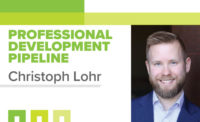“You may be whatever you resolve to be.”
During my four years at the Virginia Military Institute, those words looked down on me as I walked in and out of the main arch to the VMI barracks (i.e., VMI’s spartan version of a dormitory) — particularly my first year as a “rat,” when that was the only arch I was permitted to use. That sentence has branded itself on my mind, as it has on many cadets and alumni from the school. As a result, I likely ended up with a predisposition to believing that through hard work, focus and an open mind, I could do almost anything in my life. In many ways, VMI began to form the circle on this subject, which was completed years later after graduation.
About a year post-graduation, I began listening to a podcast called, “Manager Tools.” Within the main podcast, they had a subset of podcasts called “Career Tools,” which applied to listeners who were either managers or direct reports. I can’t recommend those podcasts enough (and I likely have 123,000 co-members who would agree with me). The hosts, Mark Horstman and Mike Auzenne — both West Point graduates — introduced me to the idea that I have dubbed, “Growth mindset” (or more recently #GrowthMindset). It goes something like this:
“The stock market grows, on average, about 8% to 10% per year. That means, at a macro level, if a company doesn’t grow or improve by 10% every year, they will fall behind their competitors and likely go out of business. It also means that if you as an individual don’t grow or improve at a 10% rate every year, you will also fall behind the market, and possibly leave you stagnant or jobless, especially in the event of a market turn-down.”
I feel so fortunate to have stumbled across this podcast, especially this particular lesson (they have seemingly a million others to which you need to listen). #GrowthMindset is something that has become a bigger and bigger part of who I am as a professional, and in my observation, professionals who have that mindset are the ones who really flourish.
Defining #GrowthMindset
So what exactly is #GrowthMindset? Let’s first talk about its opposite: A fixed mindset. This is the idea that “You are who you are,” and that “People don’t really change.” It’s the idea that people, once fully developed, are static (i.e., fixed). It subscribes to the idea that people should stick to what they know, stay in their lane and avoid challenges. As a result, they often give up easily. Someone who has a fixed mindset might frequently say, “It wasn’t meant to be.”
#GrowthMindset abhors “fixed mindset” thinking. # GrowthMindset believes that failure is an opportunity for growth, and thus tries new things. That intelligence can be developed. That challenges are meant to be embraced. It proclaims that “You may be whatever you resolve to be,” and that people are capable of incredible change — if they choose. There are many ways to practice #GrowthMindset; a complete list will never be made. In practice, #GrowthMindset might look somewhat like the following:
- Read books. Studies show that the average CEO reads about 60 books per year. If they can find the time, what is your excuse?
- Listen to podcasts or audiobooks in lieu of music. Note: I’m sure I will get flack for this, but did you know that music affects not only your mood but also your cognition, for better or worse? Studies show that music reprograms your brain. Why take the risk by listening to the wrong type of music?
- Volunteer to serve on a society or chapter association or nonprofit board to gain leadership experience.
- Do a “strategic side gig” if you want to change careers or push your career in a new direction (say from engineering consulting to technical sales). For example, if you want to become a photographer, volunteer to take pictures for religious events or friends’ milestones, or other events for free. Read this article about “The Strategic Side Gig” for more information.
- Sign up to take an exam to gain a certification for your employment. (Mind hack: Did you know that signing up for an exam will push most of us to begin the process of studying? Don’t wait to become an expert; sign up and then watch your motivation to study grow. Worst case: If you fail, you still will know more coming out than you did going in.) Read my related article in PM Engineer: “How code or specialty plumbing certification sets you apart as a contractor or engineer.”
- Write an article for an industry publication (like PM Engineer!) to become a better writer.
- Go to industry technical seminars and conferences.
- Reach out (call, message, email, etc.) to someone you think is an expert and ask him or her to mentor you.
- Do Toastmasters or sign up to give a short seminar on a professional topic you are passionate about to become a better public speaker.
- Say “yes” to work assignments that may push you outside your comfort zone. Worst case: You fail, but still learn something in the process. Best case: You learn something new and your skill set and reputation grow. Note: I am sure someone is going to say, “But Christoph, worst case is you fail and get fired.” I am sure that is possible. But let me ask you this in response: Would you rather work for an organization that lets people experiment (within reason) and allows them to fail, learn and grow? Or would you rather work for an organization that punishes failures of people who tried going above and beyond? If you get fired for volunteering and failing, that says more about the organization than about you, and count your blessings that you do not have to work in that environment any longer.
Does the above list sound crazy? Perhaps. For what it’s worth, I have done all of the aforementioned 10 items over the past 12 years. I did not do them all at once. I also failed at many of the tasks. I am still working on some of the items. Being open to learning is probably the best thing I ever did in my personal and professional life. I wish I would have been more intentional early on in my career, but I had to learn that as I have gone along. And that is entirely the point.




